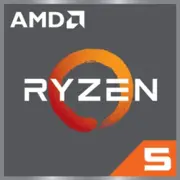AMD Ryzen 5 Pro 8500G

The AMD Ryzen 5 Pro 8500G processor is a powerhouse in the world of desktop CPUs. With its Zen 4 (Phoenix) architecture and cutting-edge 4nm technology, this processor delivers impressive performance and efficiency. With a total of 6 cores and 12 threads, it can easily handle demanding tasks and multitasking with ease.
The base frequency of 4.1 GHz and max turbo frequency of 5 GHz ensure that the Ryzen 5 Pro 8500G can handle even the most demanding applications and games. The 16MB of L3 cache further enhances its performance, allowing for quick access to frequently used data.
One of the standout features of this processor is its integrated graphics, which provides a solid level of graphical performance without the need for a dedicated GPU. This makes it an excellent choice for users who want to build a budget-friendly system without sacrificing graphics performance.
In benchmark tests, the Ryzen 5 Pro 8500G performs exceptionally well, with a Geekbench 6 Single-Core score of 2362 and a Multi-Core score of 8827.
Overall, the AMD Ryzen 5 Pro 8500G processor is a top-notch choice for those in need of a high-performance CPU for their desktop system, offering impressive performance, efficiency, and integrated graphics capabilities.
Basic
Label Name
AMD
Platform
Desktop
Launch Date
April 2024
Model Name
?
The Intel processor number is just one of several factors - along with processor brand, system configurations, and system-level benchmarks - to be considered when choosing the right processor for your computing needs.
Ryzen 5 Pro 8500G
Code Name
Zen 4 (Phoenix)
Foundry
TSMC
Generation
Ryzen 5 (Zen 4 (Phoenix))
CPU Specifications
Total Cores
?
Cores is a hardware term that describes the number of independent central processing units in a single computing component (die or chip).
6
Total Threads
?
Where applicable, Intel® Hyper-Threading Technology is only available on Performance-cores.
12
Performance-cores
2
Efficient-cores
4
Performance-core Base Frequency
4.1 GHz
Efficient-core Base Frequency
3.3 GHz
Efficient-core Max Turbo Frequency
?
Maximum E-core turbo frequency derived from Intel® Turbo Boost Technology.
3.7 GHz
Performance-core Max Turbo Frequency
?
Maximum P-core turbo frequency derived from Intel® Turbo Boost Technology.
5 GHz
L1 Cache
64 K per core
L2 Cache
6 MB
L3 Cache
16 MB
Bus Frequency
100 MHz
Multiplier
41
Unlocked Multiplier
Yes
CPU Socket
?
The socket is the component that provides the mechanical and electrical connections between the processor and motherboard.
AM5
Technology
?
Lithography refers to the semiconductor technology used to manufacture an integrated circuit, and is reported in nanometer (nm), indicative of the size of features built on the semiconductor.
4 nm
TDP
15
Max. Operating Temperature
?
Junction Temperature is the maximum temperature allowed at the processor die.
95 °C
PCIe Version
?
PCI Express is a high-speed serial computer expansion bus standard used for connecting high-speed components, replacing older standards such as AGP, PCI, and PCI-X. It has gone through multiple revisions and improvements since its initial release. PCIe 1.0 was first introduced in 2002, and in order to meet the growing demand for higher bandwidth, subsequent versions have been released over time.
4.0
Instruction Set
?
The instruction set is a hard program stored inside the CPU that guides and optimizes CPU operations. With these instruction sets, the CPU can run more efficiently. There are many manufacturers that design CPUs, which results in different instruction sets, such as the 8086 instruction set for the Intel camp and the RISC instruction set for the ARM camp. x86, ARM v8, and MIPS are all codes for instruction sets. Instruction sets can be extended; for example, x86 added 64-bit support to create x86-64. Manufacturers developing CPUs that are compatible with a certain instruction set need authorization from the instruction set patent holder. A typical example is Intel authorizing AMD, enabling the latter to develop CPUs compatible with the x86 instruction set.
x86-64
Transistor Count
20.9 billions
Memory Specifications
Memory Type
?
Intel® processors come in four different types: Single Channel, Dual Channel, Triple Channel, and Flex Mode. Maximum supported memory speed may be lower when populating multiple DIMMs per channel on products that support multiple memory channels.
DDR5-5200
Max Memory Size
?
Max memory size refers to the maximum memory capacity supported by the processor.
256 GB
Memory Channels
?
The number of memory channels refers to the bandwidth operation for real world application.
2
Max Memory Bandwidth
?
Max Memory bandwidth is the maximum rate at which data can be read from or stored into a semiconductor memory by the processor (in GB/s).
83.2 GB/s
ECC Memory Support
Yes
GPU Specifications
Integrated Graphics Model
?
An integrated GPU refers to the graphics core that is integrated into the CPU processor. Leveraging the processor's powerful computational capabilities and intelligent power efficiency management, it delivers outstanding graphics performance and a smooth application experience at a lower power consumption.
true
GPU Max Dynamic Frequency
2800 MHz
GPU Base Frequency
800 MHz
Execution Units
?
The Execution Unit is the foundational building block of Intel’s graphics architecture. Execution Units are compute processors optimized for simultaneous Multi-Threading for high throughput compute power.
4
Graphics Performance
1.43 TFLOPS
Miscellaneous
PCIe Lanes
14
Benchmarks
Geekbench 6
Single Core
Score
2362
Geekbench 6
Multi Core
Score
8827
Compared to Other CPU
Geekbench 6 Single Core
Geekbench 6 Multi Core
Share in social media
Or Link To Us
<a href="https://cputronic.com/en/cpu/amd-ryzen-5-pro-8500g" target="_blank">AMD Ryzen 5 Pro 8500G</a>